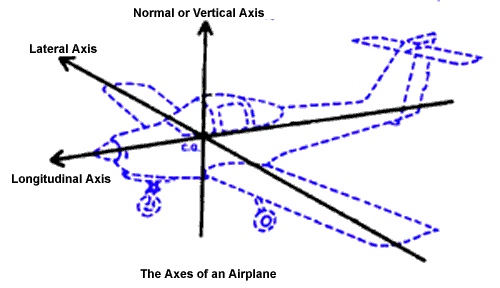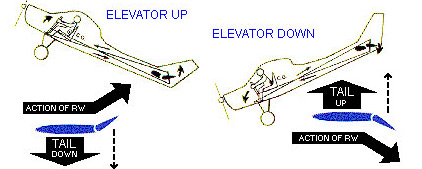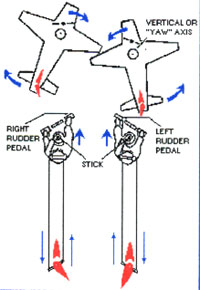FLIGHT DIRECTIONAL CONTROL THE AXES OF ROTATIONAn airplane has three axes of rotation, namely , the longitudinal axis, the vertical axis, and the lateral axis. see figure below and you will understand what we mean. The simplest way to understand the axes is to think of them as long rods passing through the aircraft where each will intersect the other two. At this point of intersection, called the center of gravity. The axis that extends lengthwise (nose through tail) is call the longitudinal axis, and the rotation about this axis is called " Roll " The axis that extends crosswise (wing tip through wing tip) is called the lateral axis, and rotation about this axis is called " Pitch " The axis that passes vertically through the center of gravity (when the aircraft is in level flight ) is called the vertical axis, and rotation about this axis is called " Yaw "The Longitudinal Axis:
The axis that extends lengthwise (nose through tail) is call the longitudinal axis, and the rotation about this axis is called " Roll " The axis that extends crosswise (wing tip through wing tip) is called the lateral axis, and rotation about this axis is called " Pitch " The axis that passes vertically through the center of gravity (when the aircraft is in level flight ) is called the vertical axis, and rotation about this axis is called " Yaw "The Longitudinal Axis:  The Axis Running from the nose to the tail of an aircraft is the longitudinal axis (see picture above). The movement around the longitudinal axis is called roll. The cause of movement or roll about the axis is the action of the ailerons. Ailerons are attached to the wing and control through the control column in a manner that ensures one aileron will deflect downward when the other is deflected upward.
The Axis Running from the nose to the tail of an aircraft is the longitudinal axis (see picture above). The movement around the longitudinal axis is called roll. The cause of movement or roll about the axis is the action of the ailerons. Ailerons are attached to the wing and control through the control column in a manner that ensures one aileron will deflect downward when the other is deflected upward.
 When an aileron is not in perfect alignment with the total wing, it changes the wing’s lift characteristics.To make a wing move upward, the aileron on that wing must move downward. The wing that has aileron downward produce more lift on that wing. the wing that has the aileron upward will reduce lift on that wing . This cause the aircraft to roll.
When an aileron is not in perfect alignment with the total wing, it changes the wing’s lift characteristics.To make a wing move upward, the aileron on that wing must move downward. The wing that has aileron downward produce more lift on that wing. the wing that has the aileron upward will reduce lift on that wing . This cause the aircraft to roll. The ailerons are attached to the cockpit control column by mechanical linkage. When the control wheel is turned to the right (or the stick is move to the right ), the aileron on the right wing is raised and the aileron on the left wing is lowered. This action increases the lift on the left wing and decreases the lift on the right wing, thus causing the aircraft to roll to the right. Moving the control wheel or stick to the left reverses this and causes the aircraft to roll to the left.The Lateral Axis
The ailerons are attached to the cockpit control column by mechanical linkage. When the control wheel is turned to the right (or the stick is move to the right ), the aileron on the right wing is raised and the aileron on the left wing is lowered. This action increases the lift on the left wing and decreases the lift on the right wing, thus causing the aircraft to roll to the right. Moving the control wheel or stick to the left reverses this and causes the aircraft to roll to the left.The Lateral Axis  The lateral axis runs from wingtip to wingtip.The movement around the lateral axis is called pitch.What causes this pitching movement ?. It is the elevator which is attached to the horizontal stabilizer. The elevator can be deflected up or down as the pilot moves the control column (or stick) backward or foreward. Movement backward on the control column moves the elevator upward. (see picture above) The relative wind (RW) striking the top surface of the raised elevator pushes the tail downward. This motion is around the lateral axis, as the tail moves (pitches) downward, the nose moves (pitches) upward and the aircraft climbs.Movement forward on the control column moves the elevator downward . The relative wind (RW) striking the lower surface of the elevator causes the tail to pitch up and the nose of the aircraft downward causing the airplane to dives. The Vertical Axis:
The lateral axis runs from wingtip to wingtip.The movement around the lateral axis is called pitch.What causes this pitching movement ?. It is the elevator which is attached to the horizontal stabilizer. The elevator can be deflected up or down as the pilot moves the control column (or stick) backward or foreward. Movement backward on the control column moves the elevator upward. (see picture above) The relative wind (RW) striking the top surface of the raised elevator pushes the tail downward. This motion is around the lateral axis, as the tail moves (pitches) downward, the nose moves (pitches) upward and the aircraft climbs.Movement forward on the control column moves the elevator downward . The relative wind (RW) striking the lower surface of the elevator causes the tail to pitch up and the nose of the aircraft downward causing the airplane to dives. The Vertical Axis:  The third axis which passes through from the top of the aircraft to the bottom is called the vertical or yaw axis. The aircraft’s nose moves about this axis in a side-to-side direction. The airplane’s rudder, which is moved by pressing on the rudder pedals which are on the floor. The airplane’s rudder is responsible for movement about this axis.The rudder is a movable control surface attached to the vertical fin of the tail assembly. By pressing the proper rudder pedal, right pedal moves the rudder to the right, and left pedal moves the rudder to the left, when pilot press the left rudder pedal, that mean the pilot sets the rudder so that it defects the relative wind to the left. This then creates a force on the tail, causing it to move to the right and the nose of the aircraft to yaw to the left
The third axis which passes through from the top of the aircraft to the bottom is called the vertical or yaw axis. The aircraft’s nose moves about this axis in a side-to-side direction. The airplane’s rudder, which is moved by pressing on the rudder pedals which are on the floor. The airplane’s rudder is responsible for movement about this axis.The rudder is a movable control surface attached to the vertical fin of the tail assembly. By pressing the proper rudder pedal, right pedal moves the rudder to the right, and left pedal moves the rudder to the left, when pilot press the left rudder pedal, that mean the pilot sets the rudder so that it defects the relative wind to the left. This then creates a force on the tail, causing it to move to the right and the nose of the aircraft to yaw to the left
حقيقة مواضيع متميزة أتمنى والله ان تستمر
بارك الله فيك يا أخي
الموضوع فيه معلومات كويسه جدا
شكرا لكم واتمني ان اكون عند حسن ظنكم
بارك الله فيكم ونرجو الكثيرررررررررررررررررررررررر
رائع
بارك الله فيك
والله من زمان نفسى اشوف هالموضوع …مشكور مشكور مشكور خيى
بارك الله فيك
موضوع رائع